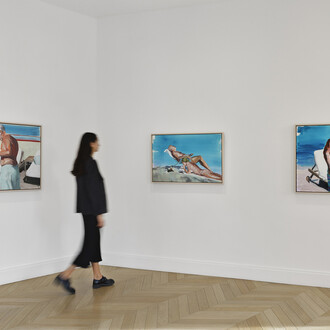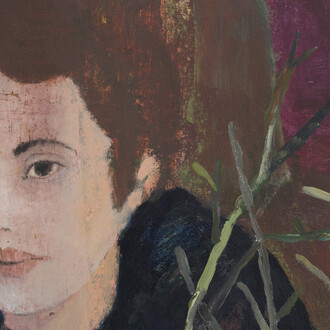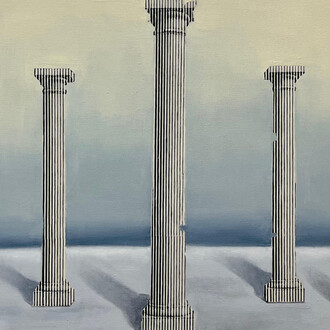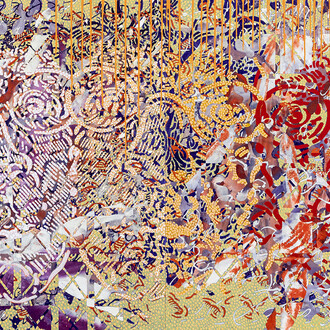Skarstedt Paris is pleased to present Andy Warhol’s figuration & the pictures generation, reuniting emblematic works by Barbara Kruger, Richard Prince, David Salle, Cindy Sherman and Rosemarie Trockel, key figures of the Pictures Generation, alongside Andy Warhol’s political portrait of Mao and cultural luminaries such as Joseph Beuys, Man Ray and Marella Agnelli. This selection draws out the visual and conceptual dialogues between Warhol’s seductive figuration and the Pictures Generation’s critical interrogation of gender, race, sexuality, media, social constructions of identity and representation.
Warhol’s iconic portraits of Mao and Joseph Beuys exemplify his approach to figuration as a site where mass media, celebrity cult, and art collide. His use of silkscreen techniques and serial repetition not only flattens individual identity into reproducible images but also reflect the artifice of fame and cultural consumption. This aesthetic of mediated identity laid critical groundwork for the Pictures Generation, whose affiliated artists similarly subvert the image-making process. Educated in the self-reflexive and critical principles of Minimal and Conceptual art, Barbara Kruger, Richard Prince, David Salle, Cindy Sherman and Rosemarie Trockel applied those lessons to consumable imagery, exploring how consumed images shape the perception of the self and the external world.
The world view of the Pictures Generation was decisively shaped by the rapid and pervasive influx of media and information that characterised the latter half of the twentieth century. In the words of curator and art critic Douglas Eklund, “the media culture of movies and television, popular music, and magazines that to them constituted a sort of fifth element or a prevailing kind of weather. Their relationship to such material was productively schizophrenic: while they were first and foremost consumers, they also learned to adopt a cool, critical attitude toward the very same mechanisms of seduction and desire that played upon them from the highly influential writings of French philosophers such as Michel Foucault and Roland Barthes.”1 This nuanced relationship with mass media finds a precedent in Warhol’s figuration, which both celebrates the cult status of celebrities and conceptualises their image through mechanical reproduction.
While Warhol blurred the boundaries between the artist, celebrity and product with knowing cynicism, the Pictures Generation expanded figuration into a more thoughtful critique of authorship, gender, and institutional structures. Richard Prince’s monumental meditation on the female body in Untitled (2012) illustrates, and even satirises, his fascination with desire and the male gaze, much like his contemporary Eric Fischl. Considered a satellite figure to the Pictures Generation, Fischl presents a delicate watercolour drawing on an impressive scale, which celebrates the female form through his quintessential voyeuristic lens.
Warhol’s portraits achieved a cult status, epitomised by his portrait of Joseph Beuys (1980). These figurative paintings exude glamour and normalised appropriation of an artistic strategy, a methodology taken further by Cindy Sherman and Barbara Kruger who used found images, advertising tropes and performative photography. Kruger’s prodigious, red painting, Untitled (Striped 2) (2019), pairs a grotesque male face from a 1950s magazine with one of her punchy, declarative statements. Much like an advertisement, Kruger addresses the viewer directly, stating ‘This is about the world in shambles.’ Similarly, Sherman’s Untitled #203 (1989) from the History portraits examines the hierarchies of power embedded within art history. Sherman mimics Ingres’ *Portrait of Charles Cordier (1777-1870) using costume, prosthetics and theatrical artifice. The unnaturalistic saturation combined with the garish gilt frame heightens the pretence of painting and wryly mocks the portrait genre.
Cindy Sherman and David Salle share similar artistic values, including the appropriation and recontextualisation of existing imagery. Salle’s vibrant diptych Shooting (1995) reflects on the fragmentation of image and meaning, combining cinematic greyscale scenes with symbolic elements like a sailboat in a bottle, rendered in a stylised, cartoonish manner that heightens the tension between realism and illusion.
Warhol’s pioneering use of popular imagery, mechanical processes and conceptual detachment opened the door for a new generation of artists to question the image itself. This exhibition demonstrates how the Pictures Generation built upon his legacy, transforming the visual language of mass culture into a critical tool for unpacking identity, authorship and representation in a media-saturated world.
Notes
1 D. Ecklund, The pictures generation 1974 – 1984, New York, Metropolitan Museum of Art and New Haven Press, 2009, p. 17.















